MULE CROSSING: Breeding Quality Mules
By Meredith Hodges

In the past, mares unsuitable for improved horse-breeding programs were the mares used for mule breeding. Looks and conformation were of little concern, since the animal that was produced had limited use for draft and farm work. In 1967, with the founding of the American Donkey & Mule Society, a new type of mule began to emerge—the American Saddle Mule—limited only by the imagination in his uses. As the mule’s popularity grew, so did the need for more carefully organized breeding programs to try to produce only the most superior mules in overall appearance and athletic ability.
In what I refer to as Phase I of our Lucky Three Ranch breeding program, my mother, Joyce Doty, successfully bred attractive, athletic and versatile mules at Windy Valley Mule Ranch in Healdsburg, California, between 1973 and 1979. They were bred for pleasure, work and show from 60 head of assorted breeds of mares. These mares included Arabians, Thoroughbreds, Tennessee Walkers, Morgans and Draft horses, but no Warmbloods.

We learned that the jacks would produce a stronger and more durable offspring, but that the heavy-boned Mammoth Jacks were not necessarily producing the most athletic—or the most attractive—saddle mule offspring. It seemed that the smaller, more refined Large Standard (48″ to 56″) and Standard Jacks (40.01″ to 48″) were better for the production of Saddle Mules. This led to Phase II of our breeding program.

Little Jack Horner, a Large Standard, was the last jack born at Windy Valley Ranch before its dispersal in 1979. In 1980 I brought him to my new Lucky Three Ranch in Colorado to become the sire supreme. My main focus was on the production of attractive, athletic, amiable and multiple-use saddle mules that would be suitable for the widest variety of uses. Beginning in 1982, Little Jack Hornerwas used with a number of different breeds of mares, including Quarter Horses, Appaloosas and a Half-Arab/Half-Quarter Crossbred. Over the next six years, as the offspring aged and matured, their abilities were quickly recognized. They excelled in all events at the shows and gave the Lucky Three its current reputation for breeding only the best.
In late 1985 I began taking a special interest in Dressage and Combined Training—the Breed shows no longer held a challenge for me. Our Quarter Horse, Appaloosa and Arabian mules competed against horses in Dressage and Combined Training and our mules were quite competitive. They were exceptional in their gaits, responsive, submissive and lovely to watch. Only two real major problems became apparent if we were to continue on this path: 1) The mules were a little too small (only14.2 to 15.3 HH) and, 2) the Quarter Horse influence caused them to be built slightly downhill, creating problems with overall balancing. It was time again to revise our breeding program.

Midnight Victory (or “Vicki,” as she was nick-named), a Trakehner cross, was born just before midnight on June 21, 1990. I had seen only one Trakehner-bred mule in my entire life, and it was the most elegant and refined mule I had ever seen, with conformation to spare. And now I had one!
Vicki was everything I have always bred for in a mule, exhibiting quality in her looks and her movement, and in and the kind of intelligence that is exalted by horsemen and women everywhere. She was the product of 17 years of selective breeding, which, in the case of the hybrid mule, can be a very lucrative and frustrating business. Frustrating because of people’s preconceived ideas about mules, because of the close attention that must be paid to selection of the right jacks and mares, and because of genetic considerations when breeding, such as Neonatal Isoerythrolisis (a condition that occurs when the mother’s blood is incompatible with her foal’s—similar to the RH negative factor that can occur in human mothers and babies).

Why a Trakehner cross? We spent years breeding donkeys before we finally got Little Jack Horner, a sire that predictably throws refined, attractive and athletic offspring, as well as producing some of the top halter mules in the country. Crossing him on Warmblood stock seemed like the natural thing to do next. We did need to be careful in choosing the type of Warmblood mare that would make the best match.

The Trakehner horse was carefully bred as a versatile and durable animal, with refinement and elegance in mind. Today, this horse plays an important role in the evolution of the mule from an ugly duckling into another beautiful swan in the American Horse Show ring.
After careful consideration of refinement and movement, we decided that the Trakehner would be the best cross. We feared that some of the other Warmblood breeds might produce too heavy an animal, something we had spent the last 17 years breeding out. In using caution and a careful breeding program, the Lucky Three Ranch was well on its way to producing the best in Sport Mules. Heartier and more athletic than their Thoroughbred and Trakehner dams, they were capable of performing in more versatile ways than were ever before imagined.
Phase III was the most exciting phase of the Lucky Three Ranch breeding program. The size and “downhill” problems had been solved, and the offspring made our dreams come true and their “presence” known. My deepest gratitude goes to all the conscientious people in the Thoroughbred and Trakehner industries for their special attention to selective breeding programs that have made it possible for us to produce such a lovely and remarkable hybrid.
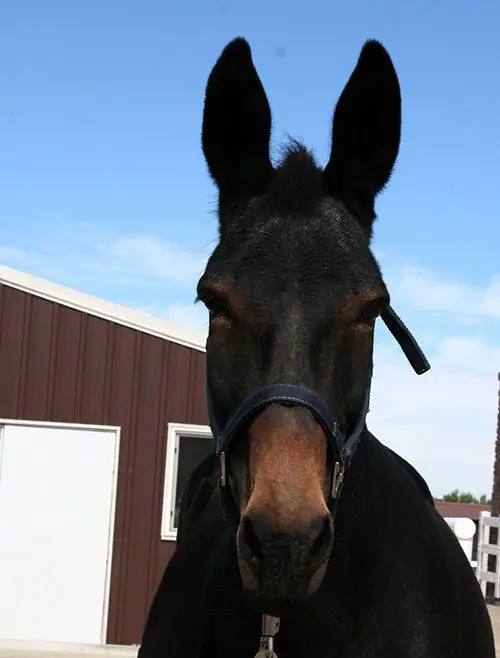 It’s hard to put your finger on it, but there’s just something a little more special about Vicki. She is way above average when it comes to mules and she definitely commandsyour attention. She embodies the spirit of free expression and an almost eerie reincarnation of a perfect dream…with long ears! Could this “presence” be something genetic, passed down through the ages of Trakehner (and possibly Arabian) breeding? It would seem so.
It’s hard to put your finger on it, but there’s just something a little more special about Vicki. She is way above average when it comes to mules and she definitely commandsyour attention. She embodies the spirit of free expression and an almost eerie reincarnation of a perfect dream…with long ears! Could this “presence” be something genetic, passed down through the ages of Trakehner (and possibly Arabian) breeding? It would seem so.
The mules of Lucky Three Ranch are living proof of what quality breeding produces. They are elegant, first-class animals that are easy keepers, inexpensive eaters and loyal, personable companions—you need only feast your eyes upon these mule offspring to be convinced!
To learn more about Meredith Hodges and her comprehensive all-breed equine training program, visit LuckyThreeRanch.com, MEREDITH HODGES PUBLIC FIGURE Facebook page, or call 1-800-816-7566. Check out her children’s website at JasperTheMule.com. Also, find Meredith on Pinterest, Instagram, MeWe, YouTube and Twitter.
Covered in TRAINING MULES & DONKEY: A LOGICAL APPROACH TO TRAINING, TRAINING WITHOUT RESISTANCE, EQUUS REVISITED and A GUIDE TO RAISING & SHOWING MULES at www.luckythreeranchstore.com
© 1990, 2011, 2016, 2019, 2020, 2022, 2024 Lucky Three Ranch, Inc. All Rights Reserved.


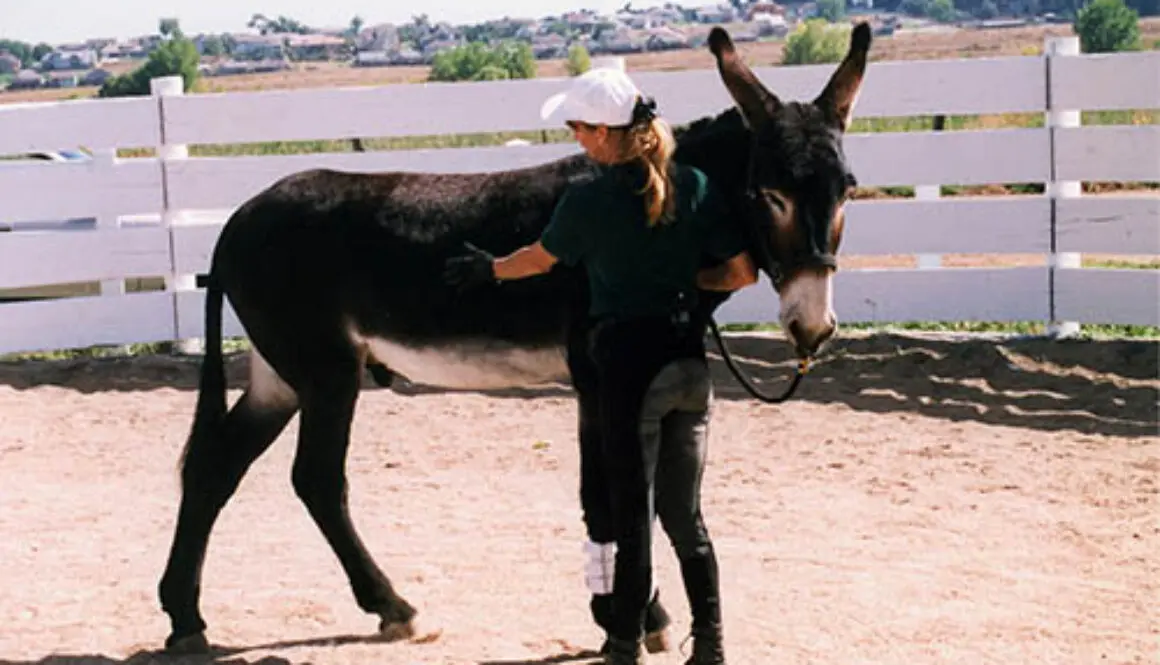
 By Meredith Hodges
By Meredith Hodges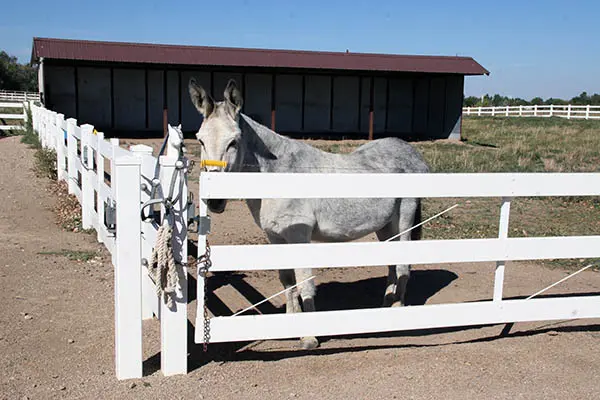 jack has a roomy area, free of refuse and debris, and adequately fenced. The fences should be high enough to discourage his leaning over the top and strong enough to bear his weight on impact. Also, they must be constructed so that there are no protrusions that could cause him injury. If females (or other animals) are present, the jack may run back and forth along the fence and catch his head on anything that is protruding. Hot wires along the inside of a weaker fence will often serve this purpose. However, a hot wire used alone is not sufficient. If your jack becomes frightened, he could run through an electric wire before he even knows that it is there. Giving him a clean, comfortable area where his limits are clearly defined will help him to be a calmer and more manageable animal.
jack has a roomy area, free of refuse and debris, and adequately fenced. The fences should be high enough to discourage his leaning over the top and strong enough to bear his weight on impact. Also, they must be constructed so that there are no protrusions that could cause him injury. If females (or other animals) are present, the jack may run back and forth along the fence and catch his head on anything that is protruding. Hot wires along the inside of a weaker fence will often serve this purpose. However, a hot wire used alone is not sufficient. If your jack becomes frightened, he could run through an electric wire before he even knows that it is there. Giving him a clean, comfortable area where his limits are clearly defined will help him to be a calmer and more manageable animal.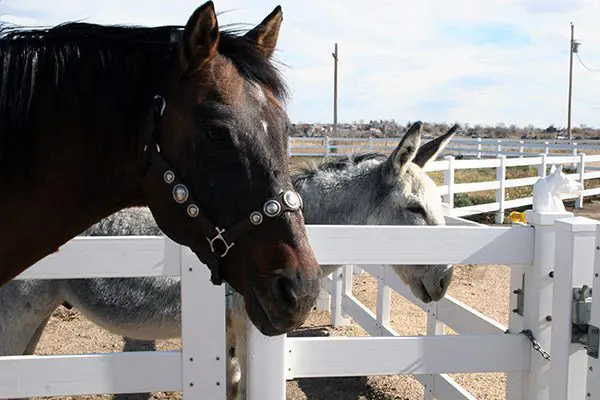 Many people opt to keep jacks in solitude, but this is not really good for them. Being a natural herd animal, they need social interaction. When they don’t have company nearby, jacks can become depressed (donkeys have actually been known to die from depression—they can stop eating and simply give up). To remedy this, jacks can be pastured or penned next to other animals, as long as the fencing is adequate between them. Of course, you also need to take into consideration the personality types of the animals involved, as well as being careful to make sure they are compatible. This can fulfill their need for companionship and keep them happy in confinement. As long as there are no cycling horse or donkey females around, jacks can be pastured next to mules of both genders. I had my own jack, Little Jack Horner, penned next to our teaser stallion for many years and they actually liked each other! We never had any trouble with them at all.
Many people opt to keep jacks in solitude, but this is not really good for them. Being a natural herd animal, they need social interaction. When they don’t have company nearby, jacks can become depressed (donkeys have actually been known to die from depression—they can stop eating and simply give up). To remedy this, jacks can be pastured or penned next to other animals, as long as the fencing is adequate between them. Of course, you also need to take into consideration the personality types of the animals involved, as well as being careful to make sure they are compatible. This can fulfill their need for companionship and keep them happy in confinement. As long as there are no cycling horse or donkey females around, jacks can be pastured next to mules of both genders. I had my own jack, Little Jack Horner, penned next to our teaser stallion for many years and they actually liked each other! We never had any trouble with them at all.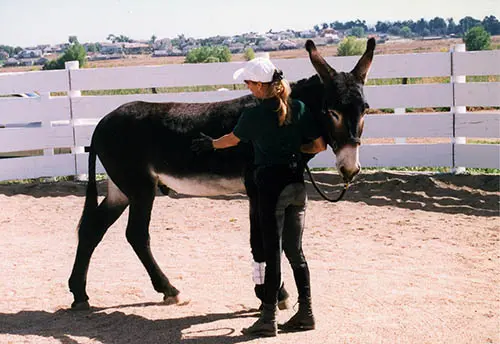 When he is flawless with his leading training, you can get him used to the bridle and a surcingle or lightweight saddle, and then move on to ground driving. Lunging is not as important, since most donkeys do not like to lunge. I suppose they don’t see much purpose in going around in a circle more than once to come back to the same place over and over again. Taking the time to properly train your donkey jack at halter and in the drivelines will enhance his obedience, and will make him more comfortable and relaxed. During the breeding process, it can even speed up his readiness.
When he is flawless with his leading training, you can get him used to the bridle and a surcingle or lightweight saddle, and then move on to ground driving. Lunging is not as important, since most donkeys do not like to lunge. I suppose they don’t see much purpose in going around in a circle more than once to come back to the same place over and over again. Taking the time to properly train your donkey jack at halter and in the drivelines will enhance his obedience, and will make him more comfortable and relaxed. During the breeding process, it can even speed up his readiness.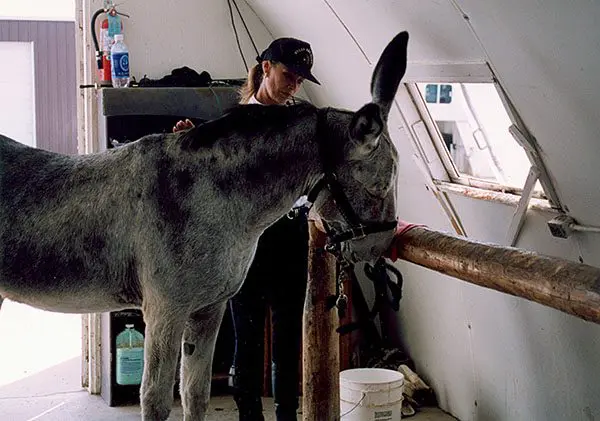 or out the door). If you are going to breed him, the mare should first be prepared. Next, once you are both out the door, ask him to whoa and square up all four feet. Then you can lead him to the breeding area, where you can then tie him to the hitch rail a little ways away from the waiting mare. By being consistent in your manner of going from the stall to the breeding area, the jack will learn not to be pushy and aggressive toward you.
or out the door). If you are going to breed him, the mare should first be prepared. Next, once you are both out the door, ask him to whoa and square up all four feet. Then you can lead him to the breeding area, where you can then tie him to the hitch rail a little ways away from the waiting mare. By being consistent in your manner of going from the stall to the breeding area, the jack will learn not to be pushy and aggressive toward you. Just to be on the safe side with your jack while breeding, use either a muzzle or a dropped noseband (snugly fit low on his nose)—this will prevent biting injuries to you or to the mare. When he is finished, make him stand quietly behind the mare while you rinse him off. Allow him that last sniff to the mare’s behind, and then take him back to his stall (or pen), ask him to stand still while you remove the halter and then let him go. That last sniff appears to be an assertion of his act and of his manhood. If you try to lead him away before he sniffs, he might not come with you and he might become even more aggressive toward the mare. Remember to do things with your jack in a routine way, and always with safety in mind—this will allow him to relax and use the manners he has learned. NOTE: Women who are menstruating should never handle jacks or stallions during that particular time, since the scent can trigger aggressive and dangerous behaviors in these animals.
Just to be on the safe side with your jack while breeding, use either a muzzle or a dropped noseband (snugly fit low on his nose)—this will prevent biting injuries to you or to the mare. When he is finished, make him stand quietly behind the mare while you rinse him off. Allow him that last sniff to the mare’s behind, and then take him back to his stall (or pen), ask him to stand still while you remove the halter and then let him go. That last sniff appears to be an assertion of his act and of his manhood. If you try to lead him away before he sniffs, he might not come with you and he might become even more aggressive toward the mare. Remember to do things with your jack in a routine way, and always with safety in mind—this will allow him to relax and use the manners he has learned. NOTE: Women who are menstruating should never handle jacks or stallions during that particular time, since the scent can trigger aggressive and dangerous behaviors in these animals.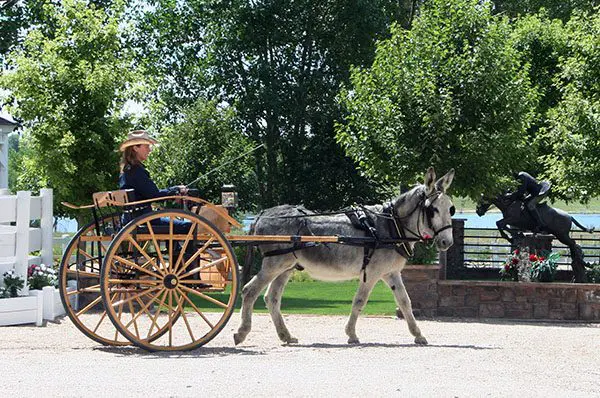 plenty of time and done your homework during his leading lessons, your jack will learn to be obedient on the lead shank, even during breeding.
plenty of time and done your homework during his leading lessons, your jack will learn to be obedient on the lead shank, even during breeding.
 By Meredith Hodges
By Meredith Hodges Mule foals are not too much different than human infants in their emotional needs. They require lots of attention, love, guidance and praise if they are to evolve into loving, cooperative and confident adults. In your efforts to get your young foal trained, bear in mind that he is still a child. If he is expected to fulfill too many adult responsibilities too quickly, he can become overwhelmed, frustrated and resistant. This is why it is important to allow your foal to have a childhood. You can turn this time into a learning experience by playing games with your foal that will help him to prepare for adulthood without imposing adult expectations on him when he is too young.
Mule foals are not too much different than human infants in their emotional needs. They require lots of attention, love, guidance and praise if they are to evolve into loving, cooperative and confident adults. In your efforts to get your young foal trained, bear in mind that he is still a child. If he is expected to fulfill too many adult responsibilities too quickly, he can become overwhelmed, frustrated and resistant. This is why it is important to allow your foal to have a childhood. You can turn this time into a learning experience by playing games with your foal that will help him to prepare for adulthood without imposing adult expectations on him when he is too young. The first component of developing a well-adjusted adult mule is to establish a routine that will give your mule foal a sense of security and trust in you. Having a definite feeding schedule can help a lot. If you take a few minutes each morning and evening to scratch and pet your foal while your foal’s dam is eating and after he has finished nursing, he will associate you with a very pleasurable experience. If his dam is busy eating, she will be less likely to think about running off with him. If your animals are on pasture, a short visit once or twice a day with a ration of oats and plenty of petting while paying special attention to the intensity of your touch on his body will accomplish the same thing.
The first component of developing a well-adjusted adult mule is to establish a routine that will give your mule foal a sense of security and trust in you. Having a definite feeding schedule can help a lot. If you take a few minutes each morning and evening to scratch and pet your foal while your foal’s dam is eating and after he has finished nursing, he will associate you with a very pleasurable experience. If his dam is busy eating, she will be less likely to think about running off with him. If your animals are on pasture, a short visit once or twice a day with a ration of oats and plenty of petting while paying special attention to the intensity of your touch on his body will accomplish the same thing. When your mule gets a little older and is ready to be halter broken, you can use your pleasurable status with him to your advantage. First, halter him and tie him to a fence with a safety knot (see DVD #1 n my Training Mules and Donkeys series). Leave him like this each day after breakfast for about half an hour, making sure to return to him every ten minutes. Each time you return, if he doesn’t become tense and struggle, untie him and ask him to follow you. If he refuses, just tie him up again and come back again ten minutes later and try again. If he comes with you, even if it is only one step the first time, take his halter off and play with him for a little while and then end the lesson. This will maintain your pleasurable status with your foal while he learns the things he will need to know as a young adult. In the next lesson you can ask for more steps before playing and ending the lesson
When your mule gets a little older and is ready to be halter broken, you can use your pleasurable status with him to your advantage. First, halter him and tie him to a fence with a safety knot (see DVD #1 n my Training Mules and Donkeys series). Leave him like this each day after breakfast for about half an hour, making sure to return to him every ten minutes. Each time you return, if he doesn’t become tense and struggle, untie him and ask him to follow you. If he refuses, just tie him up again and come back again ten minutes later and try again. If he comes with you, even if it is only one step the first time, take his halter off and play with him for a little while and then end the lesson. This will maintain your pleasurable status with your foal while he learns the things he will need to know as a young adult. In the next lesson you can ask for more steps before playing and ending the lesson When handling your mule foal, always be sure to give him time to relax and accept a situation…and he probably will. Never get in a hurry and do not try to force anything—or your foal will be happy to oblige you with more resistance than you ever imagined possible! And remember, you can catch more flies with sugar than you can with vinegar, so go out there and have a good time with your little longeared pal. He’ll be glad to be your best friend if you learn how to be his best friend.
When handling your mule foal, always be sure to give him time to relax and accept a situation…and he probably will. Never get in a hurry and do not try to force anything—or your foal will be happy to oblige you with more resistance than you ever imagined possible! And remember, you can catch more flies with sugar than you can with vinegar, so go out there and have a good time with your little longeared pal. He’ll be glad to be your best friend if you learn how to be his best friend.



